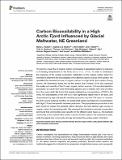Por favor, use este identificador para citar o enlazar a este item:
http://hdl.handle.net/10261/215098COMPARTIR / EXPORTAR:
 SHARE SHARE
 CORE
BASE CORE
BASE
|
|
| Visualizar otros formatos: MARC | Dublin Core | RDF | ORE | MODS | METS | DIDL | DATACITE | |

| Título: | Carbon bioavailability in a high arctic fjord influenced by glacial Meltwater, NE Greenland |
Autor: | Paulsen, Maria Lund; Nielsen, Sophia E. B.; Müller, Oliver; Møller, Eva F.; Stedmon, Colin A.; Juul-Pedersen, Thomas; Markager, Stiig; Sejr, Mikael K.; Delgado Huertas, Antonio CSIC ORCID ; Larsen, Aud; Middelboe, Mathias | Fecha de publicación: | 8-jun-2017 | Editor: | Frontiers Media | Citación: | Frontiers in Marine Science 4: 176 (2017) | Resumen: | The land-to-ocean flux of organic carbon is increasing in glacierized regions in response to increasing temperatures in the Arctic (Hood et al., 2015). In order to understand the response of the coastal ecosystem metabolism to the organic carbon input it is essential to determine the bioavailability of the different carbon sources in the system. We quantified the bacterial turnover of organic carbon in a high Arctic fjord system (Young Sound, NE Greenland) during the ice-free period (July-October 2014) and assessed the quality and quantity of the 3 major organic carbon sources; (1) local phytoplankton production (2) runoff from land-terminating glaciers and a lowland river and (3) inflow from the ocean shelf. We found that despite relatively low concentrations of DOC in the rivers, the bioavailability of the river-DOC was significantly higher than in the fjord, and characterized by high cell-specific bacterial production and low C:N ratios. In contrast, the DOC source entering via inflow of coastal shelf waters had high DOC concentrations with high C:N and low specific bacterial production. The phytoplankton production in the fjord could not sustain the bacterial carbon demand, but was still the major source of organic carbon for bacterial growth. We assessed the bacterial community composition and found that communities were specific for the different water types i.e., the bacterial community of the coastal inflow water could be traced mainly in the subsurface water, while the glacial river community strongly dominated the surface water in the fjord. | Versión del editor: | http://dx.doi.org/10.3389/fmars.2017.00176 | URI: | http://hdl.handle.net/10261/215098 | DOI: | 10.3389/fmars.2017.00176 | Identificadores: | doi: 10.3389/fmars.2017.00176 issn: 2296-7745 |
| Aparece en las colecciones: | (IACT) Artículos |
Ficheros en este ítem:
| Fichero | Descripción | Tamaño | Formato | |
|---|---|---|---|---|
| Delgado_A_FrontiersMarine4.pdf | 4,32 MB | Adobe PDF |  Visualizar/Abrir |
CORE Recommender
SCOPUSTM
Citations
37
checked on 16-may-2024
WEB OF SCIENCETM
Citations
39
checked on 17-feb-2024
Page view(s)
123
checked on 16-may-2024
Download(s)
100
checked on 16-may-2024
Google ScholarTM
Check
Altmetric
Altmetric
Este item está licenciado bajo una Licencia Creative Commons

